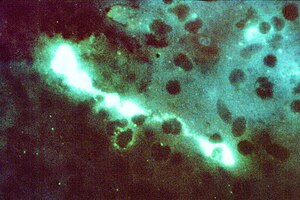Psittacosis—also known as parrot fever, and ornithosis—is a zoonotic infectious disease in humans caused by a bacterium called Chlamydia psittaci and contracted from infected parrots, such as macaws, cockatiels, and budgerigars, and from pigeons, sparrows, ducks, hens, gulls and many other species of birds. The incidence of infection in canaries and finches is believed to be lower than in psittacine birds.
In certain contexts, the word is used when the disease is carried by any species of birds belonging to the family Psittacidae, whereas ornithosis is used when other birds carry the disease.[1]
Differential diagnosis must be made with typhus, typhoid, and atypical pneumonia by Mycoplasma, Legionella, or Q fever.
Psittacosis was first reported in Europe in 1879.[7]
In 1929, a highly publicized outbreak of psittacosis hit the United States. Although not the first report of psittacosis in the United States, it was the largest up to that time. It led to greater controls on the import of pet parrots.[7] The aftermath of the outbreak and how it was handled led to the establishment of the National Institutes of Health.[8]
Psittacosis was one of more than a dozen agents that the United States researched as potential biological weapons before the nation suspended its biological weapons program.[11]
In 1930, during the 1929–1930 psittacosis pandemic, Lena Rose Pepperdine died in 1930 of parrot fever. She was the first wife of George Pepperdine, the founder of Pepperdine University.[12]
| Psittacosis | |
|---|---|
 | |
| Direct fluorescent antibody stain of a mouse brain impression smear showing C. psittaci | |
| Specialty | Infectious medicine Pulmonology |
https://en.wikipedia.org/wiki/Psittacosis
| Spirochaete |
| ||||||||||
|---|---|---|---|---|---|---|---|---|---|---|---|
| Chlamydiaceae |
| ||||||||||
| Bacteroidetes | |||||||||||
| Fusobacteria | |||||||||||
https://en.wikipedia.org/wiki/Psittacosis
No comments:
Post a Comment